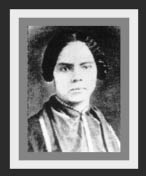 |
 |
|||||
 |
||||||
 |
||||
 |
||||
 |
||||
|
PROFILE Mary Ann Shadd Cary: 1823-1893 By Lola Sutton, St. Albans, NL
Mary was born to Abram and Harriet Shadd in Wilmington, Delaware in the year 1823. At that time, it was forbidden for black people to be educated in Delaware because slavery was still a very common practice in the United States. Thus, at the age of ten, she was placed in a Quaker boarding school where she would have the chance to receive an education. In 1850, the Fugitive Slave Act was passed in the United States. This act allowed free northern blacks and southern slaves to be rounded up and sold into slavery once more after they had obtained their freedom. Thus making it that much harder for black people of that time. Because of this Act, in 1851 Mary, along with her family, fled the U.S and immigrated to Canada. Mary and her family settled in Ontario. She soon came to realize that her fellow African people were being treated with racism and were frowned upon by the whites. After fleeing from their homes and enduring slavery and now her fellow people had to face this it just didn't seem fair. She earned a teacher's degree and started teaching but the thought of doing something to help her people and the white people to come together just couldn't be shaken. Thus she decided to start up a private school where people of all races could receive an education. She believed that every individual, regardless of his or her ancestry, had equal potential to become something great if only given the chance to receive an education. Mary felt that by integrating young black and white children together, they could learn to live and work in harmony with one another, and that both parties had much to learn from each other. Unfortunately, the blacks that fled to Canada felt that they would be safe from all this discrimination and racism but at the time many Canadians were afraid of these people and didn't really understand them and thought they were all nothing but dirty runaway slaves. Thus, because of such thoughts, there was much uneasiness between both groups of people. As Mary had feared, the Canadian government sat by and allowed people to segregate blacks into certain communities. Thus blacks that had safely crossed the border into Canada had tended to stick together and rarely were involved with the whites because there was too much tension between the two groups. Although the opening of Mary's school was greatly opposed by many she stuck to her belief and continued on with the few people she had that attended her school. After reading how the papers had opposed blacks immigrating into white communities and attending integrated schools, she decided to start up her own newspaper called "The Provincial Freedom". She started the newspaper for the black community in Canada and especially for the fugitive slaves to give them hope in their time of great turmoil. In this paper she tried to help the white communities see the noble deeds of their fellow black Canadians. Mary was a very outspoken person who spoke from the heart and said exactly what she felt without a moment's hesitation. She was known in her speeches to quote Martain Luther King J .R who once said "Canada is not merely a neighbour for Negros, but deep in our history's mists of struggle for freedom, Canada was the guiding star". Mary died on June 5th , 1893 and is best remembered for being a great black teacher, political activist, journalist and a great speaker for both her peoples rights and the rights of women. Mary left behind a great legacy in writing, publishing, education and law. She followed her dreams to integrate black and white comminutes, though her dream was never achieved in her lifetime, her efforts paved the way for many other black and white people to fight for similar reasons. Mary was known for being a person who fought for what she believed in and was able to overcome the people who opposed her and fulfill her dreams despite the hardships she had to endure along the way. Mary Ann Shadd Cary gave so much to her adopted home, Canada, helping to give our country the cultural mosaic that is has today. Information on Mary Ann Shadd Cary was obtained from the following websites: www.biography.comwww.blackhistorypages.com
|
 When thinking of who to write about for the SNN's February theme of Black History Month, I spent many countless hours trying to come up with someone via the internet, someone who made a significant contribution to Canadian society. After reading this person's biography she quickly became an inspiration to me as a writer as she too was a writer. This was a person, a woman, who wasn't afraid to speak up for something she believed in and that woman is Mary Ann Shadd Cary. She is known for being the first ever African woman to publish and edit a newspaper in North America.
When thinking of who to write about for the SNN's February theme of Black History Month, I spent many countless hours trying to come up with someone via the internet, someone who made a significant contribution to Canadian society. After reading this person's biography she quickly became an inspiration to me as a writer as she too was a writer. This was a person, a woman, who wasn't afraid to speak up for something she believed in and that woman is Mary Ann Shadd Cary. She is known for being the first ever African woman to publish and edit a newspaper in North America.